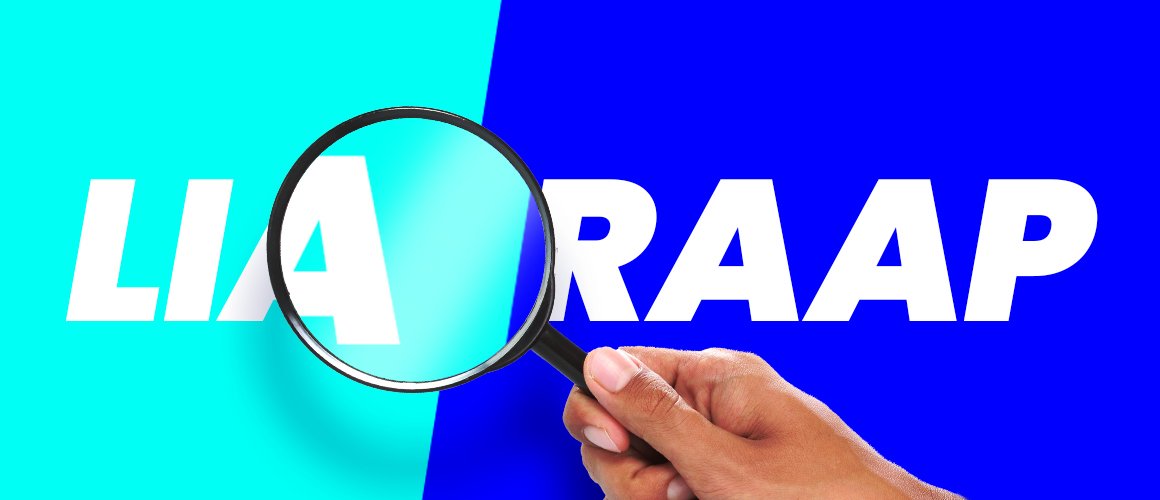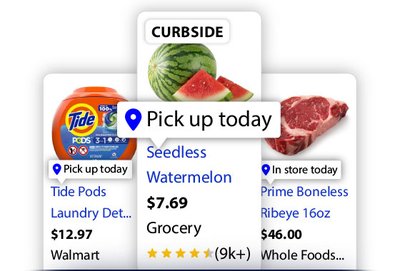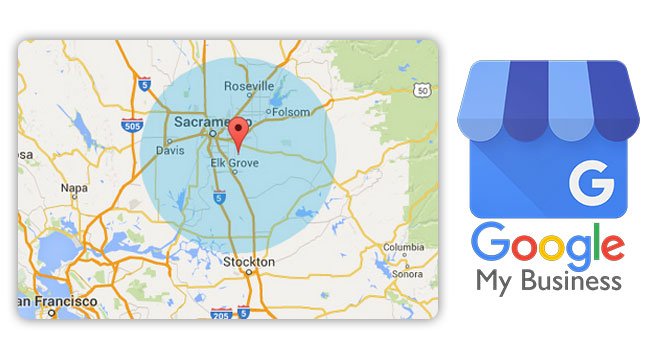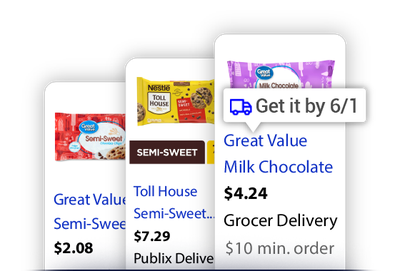
While Local Inventory Ads (LIA) and Regional Availability and Pricing (RAAP) feeds generally address completely different use cases, today we'll explore how they actually can overlap—and why that overlap often confuses advertisers.
Contents:
What is Google LIA:

Local Inventory Ads (LIA) came first and is still, generally speaking, used for driving in-store traffic—not for delivery or shipping. LIA "breaks the mold" of the standard online shopping experience because it focuses on targeting local shoppers who are physically near a store. LIA ads can also promote “Buy Online and Pickup In-Store” (BOPIS) as well as “Curbside Pickup,” often featuring badging like “In stock nearby” or “1.5 miles away”—all emphasizing an in-person shopping experience.
At some point, however, Google realized that they had all this in-store LIA data, and some of these stores also offered local delivery. Google decided to let stores advertise this, but it wasn’t entirely simple. Just because a product exists in-store doesn’t necessarily mean it can be delivered. How could Google modify the LIA feeds to allow merchants to specify that certain items could indeed be delivered?
This was accomplished by adding a new column, "local_shipping_label," to the LIA feeds which, if configured properly, will now allow merchants to also advertise delivery for certain items. Of course, in doing this, it adds some confusion to the general LIA product offering: is it for in-store purchases, to advertise local delivery, or both?
Well, it’s really both, but primarily it’s geared toward in-store purchases. That was the original intent, and ad copy often promotes the in-store aspect. The ability to also advertise delivery is an optional add-on. Clients should generally view LIA as a solution to help boost in-store traffic.
But then why was RAAP created? If the existing LIA features could also advertise delivery, what was the reason for rolling out yet another inventory model? The reason is that LIA still has some fundamental shortcomings:

- Delivery zones are tied to a physical store location in Google My Business (GMB) and the zones have limited configurability.
- Store locations are assumed to be "open to the public." If you're doing delivery from a distribution center or fulfillment center that doesn't allow shoppers, LIA can't be used.
- LIA requires locations to be entered in GMB, which may be a burden or something the client doesn’t wish to publish.
- Other unknown factors that Google may have seen internally.
What is Google RAAP?

So, RAAP was developed by Google and, for all intents and purposes, is just another PLA ad. Remember: RAAP is just for delivery—just like PLAs have always been and like e-commerce has typically been—so the RAAP-enabled PLA ads will always look identical to normal PLA ads. To an end user, there is no difference: the customer visits a website, pays, the item is shipped, and it arrives at their house. Whether it’s labeled as “delivery” or uses standard UPS/FedEx shipping is somewhat irrelevant to viewers of the PLA ads—the item will arrive at their house, and the PLA ad looks the same.
RAAP allows for a bit more flexibility than LIA, however: you can specify delivery regions with more options, and you don’t need a physical store centered in those regions like LIA. Additionally, with RAAP, you’re not required to advertise “local ads.” For example, you can advertise warehouse delivery without mistakenly driving in-store traffic to a non-public warehouse.
Lastly, classic PLA ads also have a healthy amount of overlap. Classic PLA ads (non-LIA, non-RAAP) can still support complex shipping rules. For example, they can be configured to ship only to certain areas (like wine) or charge extra for shipping to distant locations (like furniture). However, these shipping options become very complex when multiple warehouses or stores are involved. That’s when we recommend LIA or RAAP.
Confused yet? It’s a lot to take in!
Here’s a high-level summary of the three options:
SUMMARY:

PLA (no LIA, no RAAP): The client wants to advertise shipping their products to customers and typically ships throughout the destination country. The client may have multiple warehouses, but products are the same price and can generally use any warehouse to ship anywhere in the country.
LIA: The client primarily wants to advertise to boost in-store traffic. As a lightweight add-on, the client could optionally advertise store delivery as well—assuming (a) the public can shop at their store locations (i.e., it’s a public store, not a distribution center) and (b) their delivery zones closely match their store locations and are simple. However, the primary use case for these ads is boosting in-store traffic!
RAAP: The client primarily wants to advertise for delivery or shipping but has multiple warehouses. Prices may vary between warehouses. Delivery rules may also be more complex than what LIA would allow for and far more complex than what standard PLA supports.
VersaFeed has been handling complex LIA and RAAP solutions for large enterprise clients since 2014, when LIA was first introduced. Contact us today to learn how to use these complex inventory systems in a straightforward fashion.
Frequently Asked Questions About Google LIA and RAAP
-
What are Google Local Inventory Ads (LIA)?
Google Local Inventory Ads (LIA) are Shopping ads that show nearby consumers the products you have available in your physical stores. When users click the ad, they’re taken to a local storefront—either hosted by you or by Google—where they can see product availability, store hours, directions, and more. LIA helps drive foot traffic by connecting in-store inventory with online search behavior.
-
How do Local Inventory Ads differ from regular Google Shopping Ads?
Local Inventory Ads focus on driving in-store visits by showcasing local availability of products, while standard Google Shopping Ads direct users to an online product page for eCommerce checkout. LIAs display a “Pick up in store” option and prioritize nearby searches, making them ideal for retailers with physical locations.
-
How do I set up Google Local Inventory Ads?
To set up Google Local Inventory Ads, follow these steps:
- Create or update a Google Merchant Center account.
- Upload product feed and local inventory feed with real-time availability and pricing per store.
- Verify your business locations via Google Business Profile.
- Enable the LIA program within Merchant Center.
- Create a local Shopping campaign in Google Ads.
Optionally, use a Google-hosted local storefront if you don’t have individual landing pages for each store.
-
How can I improve the performance of my Local Inventory Ads?
To boost Local Inventory Ad performance:
- Use high-quality product images and optimized titles/descriptions.
- Keep your local inventory feed updated daily or more.
- Enable store visit tracking to optimize for foot traffic.
- Use smart bidding strategies like Maximize Conversion Value or ROAS.
- Ensure store hours and location data are accurate in your Business Profile.
-
Why are my Local Inventory Ads not showing?
If your Google LIA ads aren’t showing, it could be due to:
- Feed disapprovals or policy violations
- Missing or incorrect product availability data
- Unlinked or unverified Google Business Profile
- Campaign targeting issues or limited budget
- LIA not enabled in Merchant Center
Check your Merchant Center diagnostics and Google Ads campaign settings for errors.